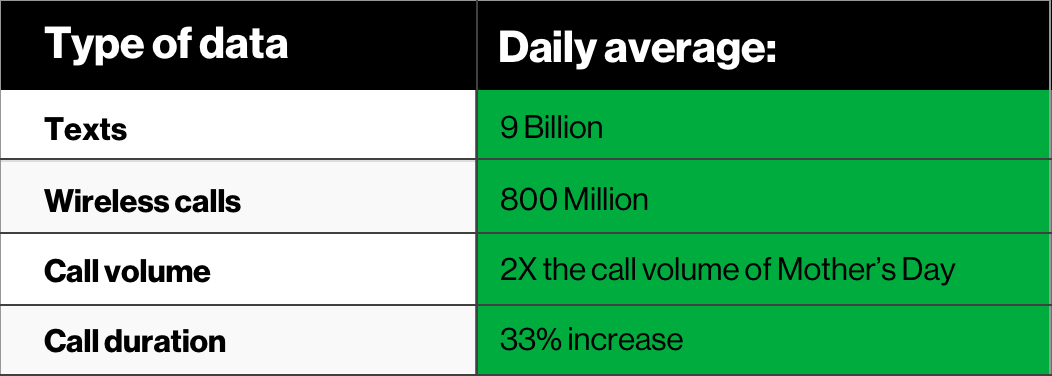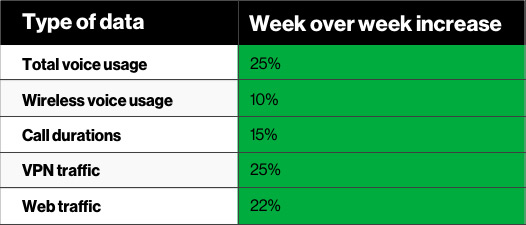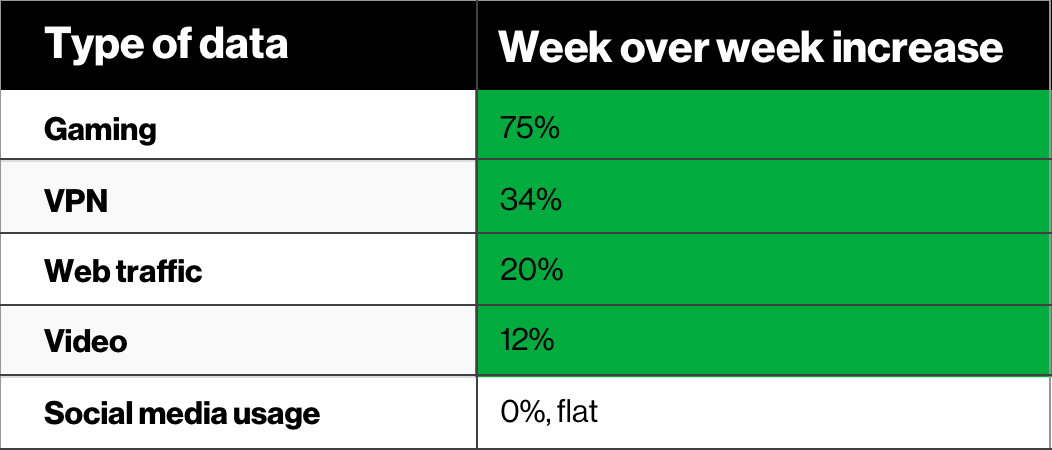People are settling into their ‘new temporary normal’ and getting back to work – remotely. Network usage continues to grow.

3/26 Update: Verizon Network Report
More than halfway through the second full week of large-scale working-from-home, the use of online collaboration tools such as conference calling applications continues to rise significantly, according to the latest Verizon Network Report. Week over week, there has been a 47% increase in use of collaboration tools on Verizon’s networks. The use of these applications drops sharply during weekends, indicating they are being used primarily for remote work and online learning.

Traffic using Virtual Private Networks (VPN), which allow people to create a secure connection over a public network (like the internet) to reach a private network, also continues to increase. It is up another 9% week over week and up 52% over a typical day.
Verizon’s wireless and broadband networks handled more than 218,000 terabytes of data this past Monday alone. That equates to 106 million hours of streaming content, 190 billion photo uploads or 38 billion songs downloaded. The network continues to perform well.
“We are seeing tremendous amounts of usage across our networks as our customers are finding new and important ways of staying connected,” said Kyle Malady, Chief Technology Officer for Verizon. “Our engineers are carefully watching changes and trends in network usage, which seems to be normalizing, and are adjusting capacity as needed. Our networks are meeting the shifting demands well and continue to show strong, consistent performance for our customers.”
BASKING RIDGE, N.J. – The Verizon network is now handling twice the number of wireless calls on weekdays compared to Mother’s Day, according to the latest Verizon Network report. Verizon’s fiber optic and wireless networks continue to perform well, meeting the shifting demands of customers during this unprecedented time.
3/24 Update: Verizon Network Report
Americans Increasingly Staying in Place
Mobile handoffs – the times when a data session moves from one cell site to another as users walk or drive around, are down 27% vs. a typical week, indicating people are increasingly staying in place. As people are being asked to stay physically distant, they are finding alternate ways to stay connected through a significant rise in calls, text and picture messages.
Verizon is reporting:
- An average of nine billion texts each day on its wireless network.
- An average of 800 million wireless calls each weekday – nearly twice the call volume of Mother’s Day.
- Call durations are up 33% vs. a typical day, meaning not only are people calling more, they are staying on the phone longer.

“Typically, Mother’s Day is always our highest Sunday call volume,” said Kyle Malady, Chief Technology Officer for Verizon. “The weekday calling numbers are now significantly exceeding the national holiday honoring Mom.
“The Verizon networks are built to keep people connected and though we are seeing changes in how people are connecting, we see the desire to stay connected growing,” said Malady. “Our networks are meeting customers’ changing habits. In small pockets where there has been a significant increase in usage, our engineers are quickly adding capacity to meet customers’ demand.”
Update: Verizon Network Report, reflecting March 12 compared to March 19
As Americans spend their first full week in the new temporary normal and staying at home, they are finding their voices again. Voice usage, long declining in the age of texting, chat and social media, is up 25 percent in the last week. Verizon customers are benefitting from a long-standing practice of no data caps on Verizon home broadband services.
The network report shows the primary driver of increased voice usage is accessing conference calling numbers. In addition, people are talking longer on mobile devices with: wireless voice usage notching a 10 percent increase and calls lasting 15 percent longer.
“For years we’ve seen a steady decline in the amount of time people spend talking to one another, especially on wireless devices,” said Kyle Malady, Chief Technology Officer at Verizon. “The move to staying at home has reignited people’s hunger to stay connected, voice-to-voice. Verizon’s fiber optic and wireless networks are continuing to meet the shifting demands of customers and continue to perform well.”
No data caps on Verizon home broadband internet
Verizon customers are also benefiting from the company’s long-standing practice of no data caps on its home broadband internet.
How Americans are spending their time, by the numbers:
- Total voice usage on Verizon networks is up 25%, primary driver: accessing conference call services
- Wireless voice usage up 10%, call durations up 15%
- VPN traffic is up 25%
- Web traffic is up 22%

*Based on peak data hour usage March 12 vs. March 19.
*Usage is expected to fluctuate over time; we could see new applications emerge based on customer usage patterns as more people telecommute and more students are at home.
“We are in the first full week of this new American routine and we are certainly starting to see some patterns emerge. We anticipate we will see additional significant shifts in usage over the next few weeks as people adjust and adapt to the changing circumstances,” said Malady. “Our engineers are continuing to closely monitor network usage patterns 24×7 and stand ready to adjust resources as changing demands arise.”
3/17 Update: Verizon Network Report, reflecting March 9 compared to March 16, 2020
The latest week-over-week numbers during peak hour usage showed many people are turning to gaming as a way to pass the time, with the technology leader seeing a 75% increase over its networks. Video streaming increased by more than 12% and overall web traffic by just under 20%.
Surprisingly, social media remained flat.
Verizon’s fiber optic and wireless networks have been able to meet the shifting demands of customers and continue to perform well. In small pockets where there has been a significant increase in usage, our engineers have quickly added capacity to meet customers’ demand.
Here’s a snapshot of usage, week over week:

*Based on peak data hour usage week over week.
*Usage is expected to fluctuate over time; we could see new applications emerge based on customer usage patterns as more people telecommute and more students are at home.
“As we see more and more individuals work from home and students engage in online learning, it is a natural byproduct that we would see an increase in web traffic and access to VPN. And as more entertainment options are cancelled in communities across the US, an increase in video traffic and online gaming is not surprising,” said Kyle Malady, Chief Technology Officer for Verizon.“We expect these peak hour percentages to fluctuate, so our engineers are continuing to closely monitor network usage patterns 24×7 and stand ready to adjust resources as changing demands arise.”
“We’re in an unprecedented situation,” said Malady. “We continually evaluate peak data usage times and build our networks to stay ahead of that demand. “While it is not clear yet how having millions of additional people working from home will impact usage patterns, we remain ready to address changes in demand, if needed.”
PR Archives: Latest, By Company, By Date